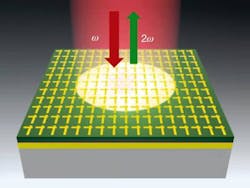Researchers at the University of Texas at Austin (UT Austin) and the Technische Universität München (Germany) have created a thin-film semiconductor structure combined with a plasmonic metasurface that produces a nonlinear optical response a million times stronger than ordinary nonlinear optical materials.1 The result is a thin-film (400-nm-thick) normal-incidence mirror that frequency-doubles light even at low powers. The prototype was designed to frequency-double light at an 8 μm wavelength to 4 μm.
No phase-matching required
In addition (and this is quite important), because the frequency conversion happens over subwavelength scales, the nonlinear mirrors do not require matching the phase velocities of the input and output waves; this eliminates a good portion of the design, setup, and tweaking processes that complicate the use of conventional bulk nonlinear crystals.
The new structures can be tailored to work at various frequencies from the near-infrared to the terahertz region. They can also be designed to produce giant nonlinear response for other nonlinear optical processes besides frequency-doubling, including sum- and difference-frequency generation, phase conjugation, and a variety of four-wave mixing processes.
About 100 alternating thin-film layers made of indium gallium arsenide (InGaAs) and aluminum indium arsenide (AlInAs) respectively, each between 1 and 12 nm thick, form the heart of the mirror; at the bottom of the structure is a layer of gold. The surface of the mirror is patterned with asymmetrical crossed gold nanostructures (see figure) to form the plasmonic metasurface; this metamaterial structure was designed and fabricated at UT Austin.
The material's giant nonlinear effect (greater than 5 × 104 pm/V) arises from the coupling of electromagnetic modes in the metasurface with electronic intersubband transitions in the carefully tailored semiconductor thin-film stack.
"This work opens a new paradigm in nonlinear optics by exploiting the unique combination of exotic wave interaction in metamaterials and of quantum engineering in semiconductors," says UT Austin professor Andrea Alu.
The research was funded by the National Science Foundation, the U.S. Air Force Office of Scientific Research, and the U.S. Office of Naval Research, as well as the German Research Foundation in the context of the Excellence Initiative (Cluster of Excellence Nanosystems Initiative Munich, NIM).
REFERENCE:
1. Jongwon Lee et al., Nature (2014); doi: 10.1038/nature13455

